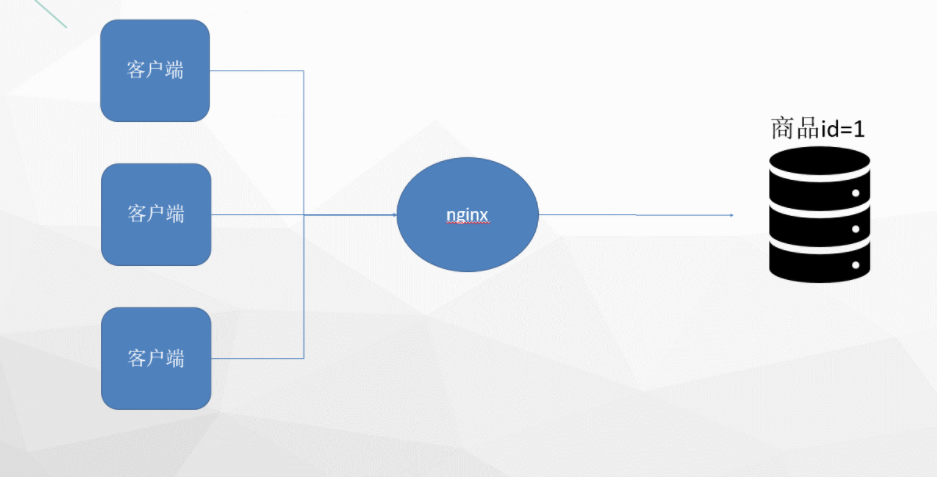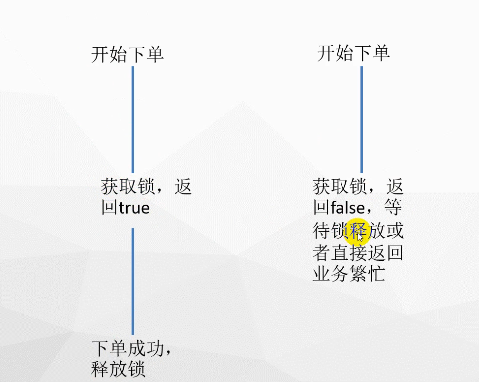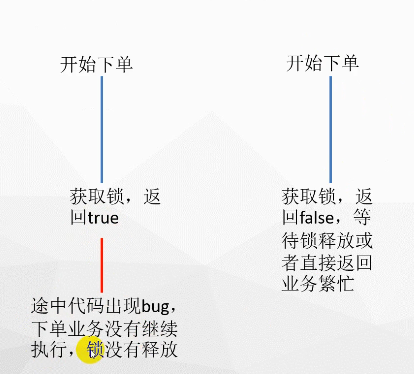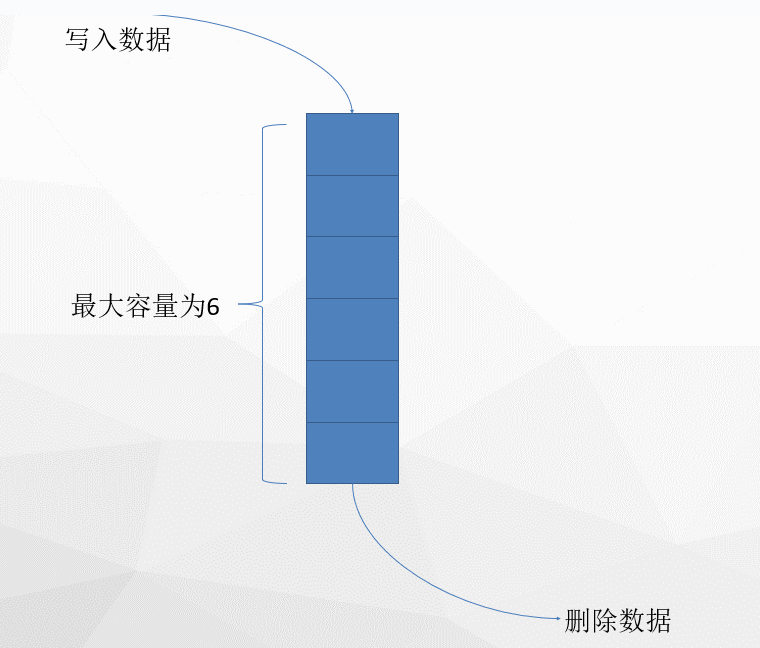>[info] Redis分布式鎖
**為什么需要分布式鎖:**

**保證互斥:**

**死鎖:**

**加鎖:**
~~~php
<?php
namespace App\Services;
use Illuminate\Support\Facades\Redis;
class RedisLockService
{
const LOCK_SUCCESS = 'OK';
const IF_NOT_EXISTS = 'NX';
const MILLISECOND_EXPIRE_TIME = 'EX';
const EXPIRE_TIME = 50; // millisecond => 50s
/**
* @param $key
* 加鎖
*/
public function lock($key,$uuid,$expire_time = '')
{
if (empty($expire_time)){
$expire_time = self::EXPIRE_TIME;
}
$ret = Redis::set($key,$uuid,self::MILLISECOND_EXPIRE_TIME , $expire_time,self::IF_NOT_EXISTS);
if ($ret == self::LOCK_SUCCESS){
return true;
}else{
return false;
}
}
/**
* 釋放鎖
*/
public function unlock($key,$uuid)
{
$lua =<<<LUA_SCRIPT
if redis.call("get",KEYS[1]) == ARGV[1] then
return redis.call("del",KEYS[1])
else
return 0
end
LUA_SCRIPT;
$restful = Redis::eval($lua,1,$key,$uuid);
return $restful;
}
}
?>
~~~
**下單:**
~~~php
<?php
public function DistributedLock($id)
{
$RedisLock = new RedisLockService();
$key = "product_".$id;
$uuid = Uuid::uuid1($id);
$uuid = $uuid->getHex();
$return = "";
try{
if (!$RedisLock->lock($key,$uuid)){
return "當前業務繁忙,請稍后";
}else{
$ret = DB::table("fm_products")->where("id",$id)->first();
if ($ret->store >0){
$ret = DB::table("fm_products")->where("id",$id)->decrement("store");
if ($ret){
$return = "下單成功";
}else{
$return = "下單失敗";
}
}else{
$return = "庫存不足";
}
$RedisLock->unlock($key,$uuid);
return $return;
}
}catch (\Exception $exception){
$RedisLock->unlock($key,$uuid);
return $exception->getMessage();
}
}
?>
~~~
>[info] 內存淘汰策略
**定期刪除:** 指的是redis默認是每隔100ms就隨機抽取一些設置了過期時間的key,檢查其是否過期,如果過期就刪除。
**惰性刪除:** 獲取某個key的時候,redis會檢查一下 ,這個key如果設置了過期時間那么是否過期了?如果過期了此時就會刪除,不會給你返回任何東西。
**其他淘汰策略:**
~~~
volatile-random:從已設置過期時間的數據集中任意選擇數據淘汰。
allkeys-random:從數據集(server.db[i].dict)中任意選擇數據淘汰
volatile-lru:從已設置過期時間的數據集中挑選最近最少使用的數據淘汰。
allkeys-lru:從數據集中挑選最近最少使用的數據淘汰
volatile-ttl:從已設置過期時間的數據集中挑選將要過期的數據淘汰。
no-enviction(驅逐):禁止驅逐數據,這也是默認策略
~~~
**lru淘汰策略:**
根據冷熱數據排序,最熱數據排在最上面,反之冷數據反正最底端。
*****
按照英文的直接原義就是Least Recently Used,最近最久未使用法,它是按照一個非常著名的計算機操作系統基礎理論得來的:最近使用的頁面數據會在未來一段時期內仍然被使用,已經很久沒有使用的頁面很有可能在未來較長的一段時間內仍然不會被使用。基于這個思想,會存在一種緩存淘汰機制,每次從內存中找到最久未使用的數據然后置換出來,從而存入新的數據!它的主要衡量指標是使用的時間,附加指標是使用的次數。在計算機中大量使用了這個機制,它的合理性在于優先篩選熱點數據,所謂熱點數據,就是最近最多使用的數據!因為,利用LRU我們可以解決很多實際開發中的問題,并且很符合業務場景。

*****
**使用php實現lru策略:**
~~~php
<?php
namespace App\Services;
class LruService
{
/*
* 頭部節點
*/
private $head;
/*
* 尾部節點
*/
private $tail;
/*
* 最大容量,大于淘汰部位節點指向上一個元素
*/
private $capacity;
/*
* 存儲key對應的節點
*/
private $hashmap;
public function __construct($capacity)
{
$this->capacity = $capacity;
$this->hashmap = array();
$this->head = new LruNodeService(null,null);
$this->tail = new LruNodeService(null,null);
$this->head->setNext($this->tail);
$this->tail->setPrevious($this->head);
}
/**
* 獲取元素
* @param $key
* @return null
*/
public function get($key)
{
if (!isset($this->hashmap[$key])) {
return null;
}
$node = $this->hashmap[$key];
if (count($this->hashmap) == 1) {
return $node->getData();
}
//先刪除已經存在的結點
$this->detach($node);
//重新將新結點插入到頭結點之后
$this->attach($this->head, $node);
return $node->getData();
}
/**
* 設置key value
* @param $key
* @param $data
* @return bool
*/
public function put($key, $data)
{
if ($this->capacity <= 0) {
return false;
}
if (isset($this->hashmap[$key]) && !empty($this->hashmap[$key])) {
$node = $this->hashmap[$key];
//重置結點到頭結點之后
$this->detach($node);
$this->attach($this->head, $node);
$node->setData($data);
} else {
$node = new LruNodeService($key, $data);
$this->hashmap[$key] = $node;
//添加節點到頭部節點之后
$this->attach($this->head, $node);
//檢測容量是否達到最大值
if (count($this->hashmap) > $this->capacity) {
//如果達到最大值 刪除尾節點左指針指向的元素
$nodeToRemove = $this->tail->getPrevious();
$this->detach($nodeToRemove);
unset($this->hashmap[$nodeToRemove->getKey()]);
}
}
return true;
}
/**
* 刪除key
* @param $key
* @return bool
*/
public function remove($key)
{
if (!isset($this->hashmap[$key])) {
return false;
}
$nodeToRemove = $this->hashmap[$key];
$this->detach($nodeToRemove);
unset($this->hashmap[$nodeToRemove->getKey()]);
return true;
}
/**
* 添加新結點到頭結點之后
* @param $head
* @param $node
*/
private function attach($head, $node)
{
//雙向鏈表插入一個元素到頭結點之后
$node->setPrevious($head);
$node->setNext($head->getNext());
$node->getNext()->setPrevious($node);
$node->getPrevious()->setNext($node);
}
/**
* 刪除結點
* @param $node
*/
private function detach($node)
{
$node->getPrevious()->setNext($node->getNext());
$node->getNext()->setPrevious($node->getPrevious());
}
}
?>
~~~
~~~php
<?php
namespace App\Services;
class LruNodeService
{
private $key;
//key對應的內容
private $data;
//結點右指針
private $next;
//結點左指針
private $previous;
/**
* Node constructor.
* @param $key
* @param $data
*/
public function __construct($key, $data)
{
$this->key = $key;
$this->data = $data;
}
/**
* Sets a new value for the node data
* @param string the new content of the node
*/
public function setData($data)
{
$this->data = $data;
}
/**
* Sets a node as the next node
* @param Node $next the next node
*/
public function setNext($next)
{
$this->next = $next;
}
/**
* Sets a node as the previous node
* @param Node $previous the previous node
*/
public function setPrevious($previous)
{
$this->previous = $previous;
}
/**
* Returns the node key
* @return string the key of the node
*/
public function getKey()
{
return $this->key;
}
/**
* Returns the node data
* @return mixed the content of the node
*/
public function getData()
{
return $this->data;
}
/**
* Returns the next node
* @return Node the next node of the node
*/
public function getNext()
{
return $this->next;
}
/**
* Returns the previous node
* @return Node the previous node of the node
*/
public function getPrevious()
{
return $this->previous;
}
}
?>
~~~
>[info] 多級緩存
1. 提速
2. 減少服務器壓力
3. 提高系統并發
*****
**Openresty安裝:**
OpenResty由中國 人章亦春發起,提供了很多高質量的第三方模塊。OpenResty 是一個強大的 Web 應用服務器,OpenResty可以快速構造出 足以勝任10K 乃至1000K以上并發連接響應的超高性能 Web 應用系統。
360,UPYUN,阿里云,新浪,騰訊網,去哪兒網,酷狗音樂等都是 OpenResty 的深度 用戶。
1. 安裝依賴
~~~
yum install readline-devel pcre-devel openssl-devel
~~~
2. 獲取安裝包解壓
~~~
wget https://openresty.org/download/ngx_openresty-1.9.7.1.tar.gz # 下載
tar xzvf ngx_openresty-1.9.7.1.tar.gz # 解壓
~~~
3. 進入安裝目錄,編譯安裝
~~~
cd ngx_openresty-1.9.7.1/
./configure
make
~~~
*****
**使用Openresty-創建lua腳本:**
1. 存 redis
~~~
ngx.header.content_type="application/json;charset=utf8"
local cjson = require("cjson") --引入模塊
local mysql = require("resty.mysql") --引入mysql模塊
local uri_args = ngx.req.get_uri_args()
local product_id = uri_args['product_id']
local db = mysql:new() --初始化數據庫
db:set_timeout(1000) --設置超時時間
local props = {
host = "192.168.29.108", --mysql ip地址
port = 3306, --mysql 端口
database = "starsky", --mysql 數據庫
user = "starsky", password = "root" --用戶名密碼
}
local res = db:connect(props) --獲得mysql連接
local select_sql = "select id,store from fm_products where id ='"..product_id.."'" --一條查詢語句
res = db:query(select_sql) db:close() --執行
local redis = require("resty.redis") --引入redis
local red = redis:new() red:set_timeout(2000) --初始化 設置超時時間
local ip ="192.168.29.108"
local port = 6379
red:connect(ip,port)
red:auth("root")
red:set("product_"..product_id,cjson.encode(res)) --存儲到redis
red:close()
ngx.say("{flag:true}")
~~~
2. 存本地
~~~
ngx.header.content_type="application/json;charset=utf8"
local uri_args = ngx.req.get_uri_args()
local product_id = uri_args['product_id']
local cache_ngx = ngx.shared.dis_cache;
local adCache = cache_ngx:get('productcache'..product_id);
if adCache == "" or adCache == nil then
local redis = require("resty.redis") --引入redis
local red = redis:new() red:set_timeout(2000) --初始化 設置超時時間
local ip ="192.168.29.108"
local port = 6379
red:connect(ip,port)
red:auth("root")
local rescontent=red:get("product_"..product_id)
ngx.say(rescontent)
red:close()
cache_ngx:set('productcache'..product_id, rescontent, 10*60);
else
ngx.say(adCache)
end
~~~
3. 配置 nginx
>[info] Redis - Key 的設計
1. 內存
2. 可讀性
**主鍵存儲查詢:**
1. 表作為key的前綴
2. 列名作為key名
3. 主鍵值保證數據唯一
4. 數據列名
**例如:**
user:username:uid:1 starsky
product:uid:store 1
*****
**非主鍵存儲查詢:**
可以先根據列名設置一個key-value的值,然后在根據查詢到的value去查詢具體的數據,例如:
Set user:username:starsky:uid 1
$uid = Get user:username:starsky:uid
$user = get user: $uid:userinfo
- PHP
- ThinkPHP5
- 變量修飾符:input()
- 常用函數封裝
- 01. 數據集轉為樹(Tree)
- 02. 生成訂單號
- 03. 將時間戳轉換為日期時間
- 04. 將字節轉換為可讀文本
- 05. 首字母頭像
- 06. 隨機小數/截取小數
- 07. 判斷字符串是否序列化
- 08. 根據生日計算年齡
- 09. 判斷是PC或WAP端
- 10. 請求網頁返回code碼狀態
- 11. 計算代碼執行時間
- 12. String 字符處理類
- 13. Http 請求類
- 14. StrRand 隨機生成字符類
- 15. 獲取當天開始時間和結束時間
- 16. 手機郵箱身份證
- 17. jsonEncode和jsonDecode助手函數
- 18. tp6跨域檢測
- 19.日期轉換為時間戳
- 20.excel導入日期格式問題
- 21.取整數函數常用的四種方法
- 22.PHPExcel導入導出
- 23.計算文件大小
- 24.計算按天數
- 25.文件夾不存在則創建
- 26.遞歸獲取部門所有子級id
- 27.根據用戶名生成默認文字頭像
- 28.生成短信驗證碼
- 29.數據脫敏
- 30.根據身份證判斷禁止未成年人下單
- 31.數組向指定位置插入元素
- 32.從字符串中獲取城市名稱
- 33.收貨地址拆分省市區
- 34.根據時間戳獲取本月開始-結束日期
- 35.循環每次查詢指定數據集
- 36.判斷日期是否符合范圍
- Laravel6
- 01.Dingo API 2.0.0 擴展包
- 01.laravel 安裝擴展包
- 02.創建端點
- 03.響應
- 04.api認證
- 監聽sql 語句
- 安裝easywechat
- 路由分組
- ThinkPHP6
- ThinkPHP6讀寫分離
- 定時計劃任務
- 偽靜態
- 多應用模式
- Join關聯查詢
- 跨域中間件
- extend擴展
- 1.操縱文件類
- 2.壓縮包驅動
- Xdebug調試
- Easy Task開發文檔
- 01.EasyTask介紹
- 02.EasyTask環境安裝
- 03.EasyTask基礎入門
- EasySwoole
- 999.狀態類
- 01.EasySwoole快速開始
- 1.EasySwoole介紹
- 2.EasySwoole快速上手
- 3.EasySwoole基本管理命令
- 4.EasySwoole基礎開始示例(CURD)
- 02.EasySwoole協程操作指南
- 1.什么是協程
- MySQL
- MySQL批量修改表前綴
- 重置【主鍵ID】
- 查看【文件存儲位置】
- MySQL主從同步
- 添加用戶權限
- MySQL主從復制集群
- 01.主從復制技術原理介紹
- 02.基于 binlog 主從復制搭建
- 03.基于binlog不影響業務搭建主從
- 04.主從復制 binlog 格式
- 05.主從復制過濾規則
- 06.在線增加從服務器
- 07.MySQL 雙主復制
- 08.雙主如何防止和解決主鍵沖突
- keepalived+haproxy+mysql雙主高可用
- lvs+keepalived+雙主mysql負載均衡
- MyCAT實現MySQL讀寫分離
- 09.多線程復制
- MHA
- 1.理解MHA高可用
- 2.搭建MySQL一主二從
- 3.建立節點互信
- 4.構建MHA
- 5.啟動并測試MHA
- 6.修復宕機的Master
- 重置root密碼
- MySQL 開發規范
- mycat
- 01.mycat 簡介與安裝
- 02.mycat 配置詳解
- 03.mycat 切片規則
- 常用SQL語句大全
- 01.取數騷SQL
- 02.評估表數據體量SQL
- Linux
- Contos 7
- 常用命令
- 解壓【zip】
- vmhgfs 掛載
- 跨主機免密碼認證
- 寶塔Linux面板
- 01.寶塔專業/企業版一鍵腳本破解版
- Windows
- 服務器
- 調出【桌面圖標】
- 查看【端口使用】
- 查看【操作日志】
- 查看【本地組策略】
- HTML
- URL編碼參照表
- RabbitMQ
- 01.rabbitMQ 快速入門
- 1. 認識 RabbitMQ
- 4. 消費者生產者代碼實例
- 3. 安裝 amqp 擴展
- 2. RabbitMQ安裝和啟動
- 02.rabbitMQ 高級特性
- 1. 高級特性前言
- 2. 高級特性之一ack comfirm機制
- 3. 高級特性之二如何保證消息的100%接收(一)
- 4. 高級特性之二如何保證消息的100%接收(二)
- 5. 高級特性之三冪等性
- 6. 高級特性之四 return機制
- 7. 高級特性之五 限流機制
- 8. 高級特性之六 重回隊列
- 9. 高級特性之七 TTL
- 10. 高級特性之八 死信隊列
- 03.tp6簡單應用 RabbitMQ
- 04.fanout 訂閱/廣播模式
- 05.topic 通配符模式
- Composer
- Composer 鏡像
- Compsoer 基礎使用
- Composer require 忽略依賴
- 微信公眾號
- 返回錯誤代碼說明
- 福利專區
- layuiAdmin框架模板
- Swoole
- 01.快速入門
- 1.swoole的概念介紹
- 2.安裝swoole
- 3. 快速運用swoole與理解
- 02.快速上手swoole與網絡協議
- 1.阻塞與非阻塞,同步與異步
- 2.HttpServer 加速php框架
- 3.WebSocket 簡單運用
- 4.tcp 與 upd 與 定時器
- 5.理解進程-非詳細
- 6.swoole結構
- 03.連接與tcp和upd
- 1.短鏈接與長連接
- 2.健康檢查
- 3.tcp 和 udp對比
- 4.tcp粘包的問題
- 5.tcp粘包問題的處理
- 04.理解網絡模型
- 1.linux內核與用戶空間調度
- 2.網絡io模型
- 3.構建worker結構iostar
- 4.理解stream系列函數
- 05.阻塞模型與非阻塞模型
- 1.構建基礎worker結構
- 2.搭建工程的結構
- 3.實現基礎版本的worker
- 4.完善worker模型
- 5.非阻塞模型與stream_select函數
- 6.補充
- 06.實現io復用與信號模型
- 07.實現異步io模型與Reactor模型
- 08.實現多進程reactor
- 09.詳解task進程
- 10.swostar之http與websocket
- 11.think-swoole使用
- 12.swostar之構建基礎核心結構
- 99.其他
- 西部數碼
- 01.NginxSLB搭建
- 02.windows 服務器取消多登錄
- PHP中高級面試題
- PHP基礎面試題
- MySQL面試題
- Redis面試題
- es面試題
- rqbbitMQ面試題
- 魔鬼訓練營
- 現場解答課-面試解答
- Laravel技術社區(干貨題庫匯總)
- 01.干貨題庫(一)
- 02.干貨題庫(二)
- 03.MySQL 常見面試題(1-25)
- 04.MySQL 常見面試題(26-58)
- Redis(2010期)
- 01.認識redis和安裝
- 02.Redis數據類型與string類型與list類型
- 03.Redis數據類型之hash類型與zset類型
- 04.Redis數據類型之set類型與性能檢測
- 05.Redis事務
- 06.Redis發布訂閱與stream應用
- 07.Redis-lua腳本
- 08.緩存擊穿,失效以及維度劃分
- 09.緩存穿透,雪崩問題
- 10.Redis緩存問題以及分布式鎖實現
- 11.redis持久化
- 1.redis-rdb持久化
- 2.redis-aof持久化
- 3.aof 和 rdb對比
- 12.redis主從復制
- 1.主從配置及原理
- 2.全量復制 和 部分復制
- 3.主從問題
- 13.redis哨兵機制
- 1.哨兵初識
- 2.redis哨兵原理
- 3.redis哨兵配置
- 4.redis哨兵問題
- 14.redis集群
- 1.集群搭建
- 2.故障轉移
- 3.redis集群伸縮
- 999.redis 常用命令
- key
- string(字符串)
- hash(哈希)
- list(列表)
- set(集合)
- zset(有序集合)
- Stream
- Redis 發布訂閱
- 事例
- Docker
- 1.docker快速入門
- 01.docker 了解
- 02.docker核心概念介紹
- 2.docker安裝
- 3.docker基本使用
- 01.常用命令(鏡像容器)
- 999.docker基本使用(示例)
- 01.docker部署es
- 02.docker部署lnmp
- 4.portainer可視化面板安裝
- 5.docker鏡像原理
- 01.docker鏡像聯合文件系統
- 02.docker分層理解
- 6.commit鏡像
- 7.docker容器數據卷
- 01.容器數據卷基本使用
- 02.容器數據卷示例
- 03.容器數據卷具名掛載和匿名掛載
- 04.多個容器數據卷數據共享
- 8.dockerFile
- 01.Dockerfile介紹
- 02.Dockerfile指令說明
- 03.發布鏡像到dockerhub
- 04.發布鏡像到阿里云
- 999.Dockerfile示例
- 01.Dockerfile構建 centos 鏡像
- 02.Dockerfile構建 tomcat 鏡像
- 03.Dockerfile構建 redis 鏡像
- 04.Dockerfile構建 lnmp 鏡像
- 9.docker網絡
- 01.理解docker0
- 02.容器互聯-link
- 03.自定義網絡
- 04.網絡互通
- 999.redis集群部署實戰
- 10.docker composer容器編排
- 01.docker-compose 介紹
- 02.安裝docker-compose
- 03.docker-compose 基本命令
- 04.docker-compose yml 常用命令
- 999.docker-compose示例
- 01.構建 nginx 鏡像(docker-compose)
- 02.構建 lnmp 鏡像(docker-compose)
- 11.docker swarm集群
- 12.ci/cd之jenkins
- 01.jenkins介紹
- 02.jenkins安裝(docker-compose)
- 13.k8s
- 01.什么是k8s
- 02.k8s使用場景
- 03.k8s部署架構分析
- 04.k8s運行架構分析
- Git
- 01.git理論和特點
- 02.gitlab安裝配置以及項目創建
- 03.用戶從windows接入并拉取+提交+修改代碼提交
- 04.如何把團隊弄進來一起開發
- 05.git基礎操作,練習命令
- 06.如果你讓三毛自己新建分支,并在上面開發這個時候三毛該怎么辦呢?
- 07.在分支開發完畢之后,如何合并到master
- 08.2個分支合并,發生沖突的演示,以及如何解決?
- 09.為什么要用git工作流,git工作流的好處
- 999.git常用命令
- phpstudy
- localhsot不顯示目錄
- tp6獲取不到header頭Authorization問題(apache)
- 分布式架構
- elk日志系統
- 01.elk為何而生
- 02.標準的日志系統包括哪些
- 03.什么是elk
- 04.架構設計分析
- 05.elk實操部署
- elasticsearch(簡稱:es)
- 01.es的簡介
- 02.es的安裝前提與安裝
- 03.es-head 與 kibana安裝
- 04.es的概念
- 05.ik分詞器
- 06.es對于restful的基本操作
- 07.es花式查詢
- 07.01 基本使用增刪改查
- 07.02 高級查詢
- 07.00 es花式搜索示例
- 01.大型互聯網架構演進過程
- 1.何為大型互聯網架構
- 2.分布式架構的演變過程
- 02.分布式通信技術介紹
- 1.分布式億級架構實戰
- 2.分布式-集群-微服務
- 3.分布式通信
- 4.分布式通信協議
- 03.分布式通信-實戰
- 1.分布式隊列原理
- 2.分布式隊列實戰
- 3.RPC代碼實戰
- 04.主流分布式架構設計詳解
- 1.分布式架構特性
- 2.CAP理論
- 3.BASE理論
- 05.consul服務注冊發現
- 1.consul的工作原理
- 2.consul集群實戰與操作
- 06.consul配置中心與實戰
- 1.配置中心是個什么
- 2.consul實現配置中心
- 3.consul的基本實戰操作
- 4.實戰跨服務調用
- 07.分布式數據庫
- 1.為什么要分庫分表
- 2.動態伸縮
- 08.分布式實戰數據庫實戰
- 09.分布式-分庫分表實戰
- 10.分布式事務
- 1.分布式事務
- 2.2PC-兩階段提交
- 3.3PC-三階段提交
- 4.TCC
- 5.MQ事務最終一致性
- 11.分布式實戰
- 12.elastic
- 13.elastic實戰
- 14.elastic場景實戰分析
- 15.elk
- 16.rabbitMQ
- 17.Kafka
- Redis、Nginx優化(2004期)
- 新能源汽車
- 數據表介紹
- 汽車租賃后臺管理
- 微信小程序授權
- 微信小程序接口
- Go
- Beego 框架
- 命令行大全
- go_zero
- 01.基礎部分
- 1.環境安裝并輸出HelloWorld
- 2.基礎語法與數據類型
- 3.Go語言變量常量定義
- 4.Go語言作用域
- 5.Go常用占位符
- 6.Go異常處理
- 7.Go中的包
- 8.指針與fmt
- 9.下劃線
- 10.數組(Array)
- 11.切片(Slice)
- 12.指針
- 13.Map
- 14.結構體
- 第三方庫
- 01.strconv
- 02.json
- 03.air實時加載
- 04.gjson
- 05.lo
- 06.time
- 07.reflect(反射)
- 08.retry-go(重試機制)
- 09.strings
- 數據庫操作
- 1.go操作mysql
- 2.go操作redis
- MongoDB
- 1.MongoDB 簡介
- 2.MongoDB 安裝
- 3.MongoDB 簡單CURD
- 4.MongoDB 條件操作符
- 5.MongoDB Limit/Skip/Sort方法
- 6.MongoDB 索引
- 7.MongoDB 聚合與管道
- 8.MongoDB 復制(副本集)
- 99. 客戶端安裝與PHP操作
- Swoft
- 01.框架安裝
- simpledingtalk修改點
- ThinkPHP6API基礎模板
- uniapp
- 01.微信小程序獲取頁面路由參數
- 02.通用提示
- 03.緩存
- 04.日期轉時間戳
- 05.VConsole調試
- Tailwind CSS
- 01.安裝以及基礎配置
- Vue
- 助手函數
- 1.時間戳格式化日期倒計時
- 2.獲取不重復的id
- 3.獲取正確的url路經
- 4.Object對象格式化為Query語法
- 5.數組轉Tree
- 6.Tree轉數組
- 7.判斷值是否為空
- 9.數字前置補零
- 10.在線時間
- 11.html轉義
- 12.pid形式數據轉children形式
- 13.遍歷children形式數據
- 14.全屏切換
- 15.獲取屏幕寬高度
- 16.獲取設備信息
- 17.百度高德地圖坐標轉換
- 18.深度克隆
- 19.獲取變量類型
- 20.播放音頻
- 21.導出excel
- 22.數字千分位
- 23.判斷是否是外鏈
- 24.獲取url參數
- ElementUI
- 1.表單驗證
- 模板
- Yii2
- 01.SQL慢查詢分塊
